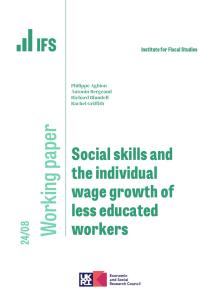Luke Sibieta, research fellow at the Institute for Fiscal Studies and the Education Policy Institute, takes a look at the impact of the apprenticeship levy so far since its introduction in May.
From May this year, all large employers have had to pay the apprenticeship levy, which equates to 0.5% of payroll bills in excess of £3m. This is estimated to raise £2.8bn a year by 2019-20. In recompense, expenditure on the costs of off-the-job training for apprentices is now effectively free (up to certain limits set by government), which applies to levy- and non-levy-paying employers in a broadly similar way. These changes have led to an increase in the expected government subsidy for apprenticeships in England from £1.8bn in 2016-17 to £2.5bn in 2019-20.
The reforms are intended to increase the numbers of apprenticeships in order to boost skills, and represent the main way in which the government is seeking to achieve its target for three million new apprenticeship starts between 2015 and 2020. Are there any early signs that these policy changes have increased numbers of apprenticeships and, in turn, the skills of workers?
On one level, the apprenticeship levy and increased subsidies have already had considerable impact. The number and range of apprenticeships available has increased as employers have sought to benefit from the subsidies on offer.
The public sector has been particularly active here, with new apprenticeships established in healthcare, education, the police and the armed forces. This is partly because many large public sector employers are looking to take advantage of subsidised training. In addition, large public sector employers are subject to a target, which says that new apprentices must represent at least 2.3% of their overall headcount each year.
The key – and as yet unanswered – question is whether increased used of apprenticeships in public sector training routes will be beneficial for the quality of public services. Most public sector training routes are long-established and mostly graduate-led. Many of these could probably benefit from reform, but it seems unlikely that setting an arbitrary, centrally imposed target and pushing public sector training routes to conform to the apprenticeship model is the best way of improving training in the public sector.
In terms of actual numbers, apprenticeship starts have actually gone down since the start of the apprenticeship levy in May. Official figures show there were about 48,000 new apprenticeship starts between May and July 2017, down 70,000 compared with the same period a year earlier. But this could be a temporary blip as employers are still transitioning to the new system.
More importantly, we should not be judging the success of the new system wholly by the number of apprenticeship starts. We should be judging them by their impact on skill levels, productivity and wages. Here, there have been grounds for concern for a long time. The proportion of people who successfully finish an apprenticeship was about 67% in 2015-16. Much of the increase in numbers since 2010 look more like relabelling of old adult training schemes like Train to Gain, and there is clear potential for apprenticeship training to just displace other forms of training. Over 50% of apprenticeship starts were at Level 2 or GCSE-equivalent level in 2016-17, with only about 8% at Level 4 or degree-equivalent level. Moreover, Ofsted has expressed significant concerns in the past about the quality of apprenticeships on offer. The controversy around Learndirect – a major provider of apprenticeship training to date – also plays into the concern that quantity is currently trumping quality.
Nevertheless, evidence shows that good-quality apprenticeships can be a route to economic success. Past research has found high returns to the apprenticeships offered by industry over the 1990s and 2000s. Ofsted has reported positively on some of the newer apprenticeships on offer, though there is still considerable variability.
These are cautious grounds for optimism. However, it means we should be focusing on quality rather than quantity. One million high-quality apprenticeships might well be better than three million lower quality ones.
This article was first published on Public Sector Executive and is reproduced here with full permission.








